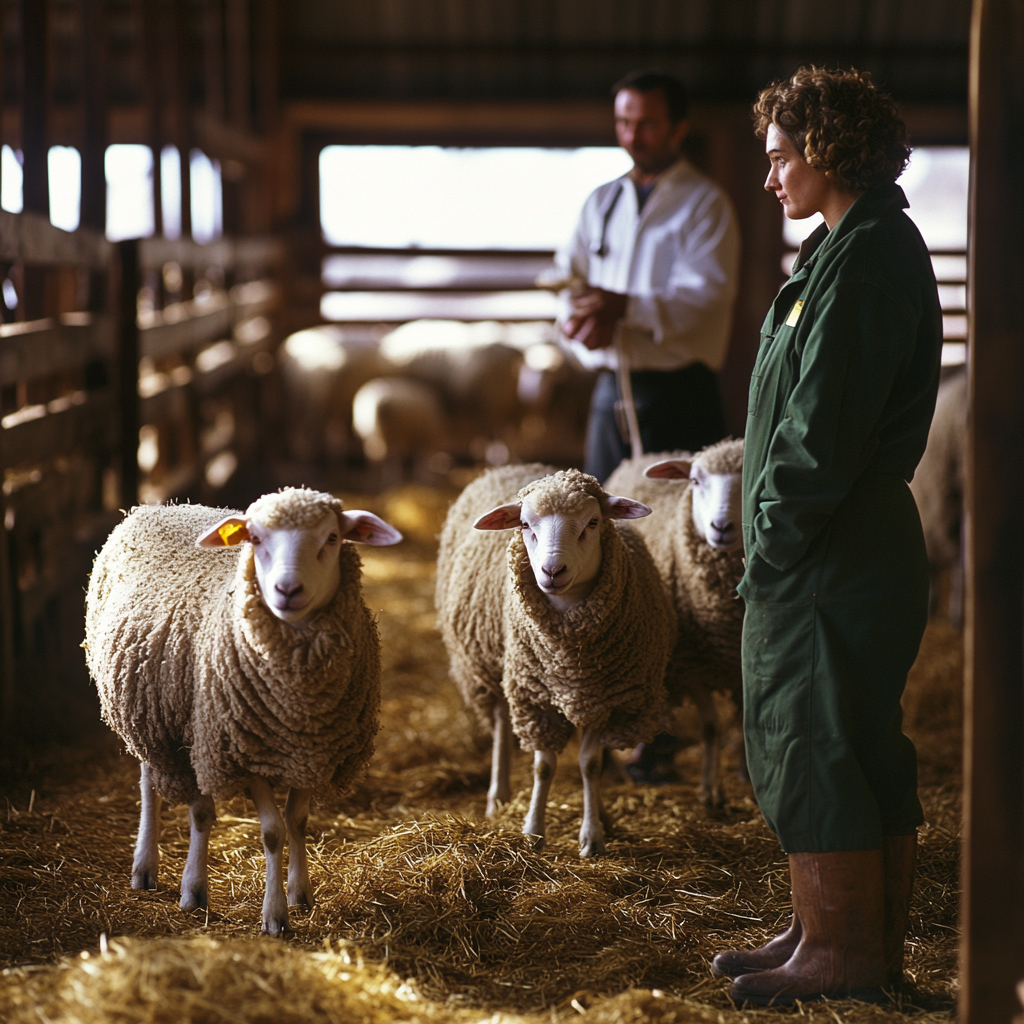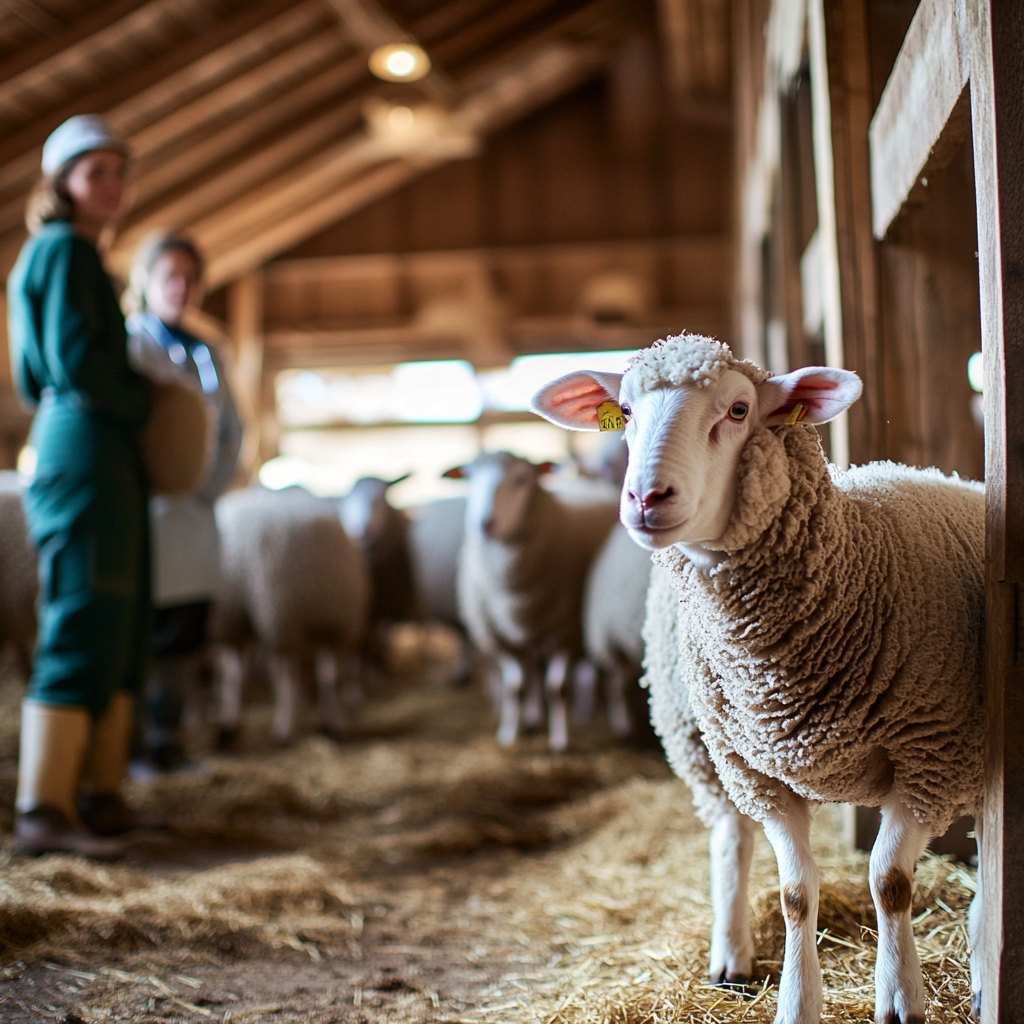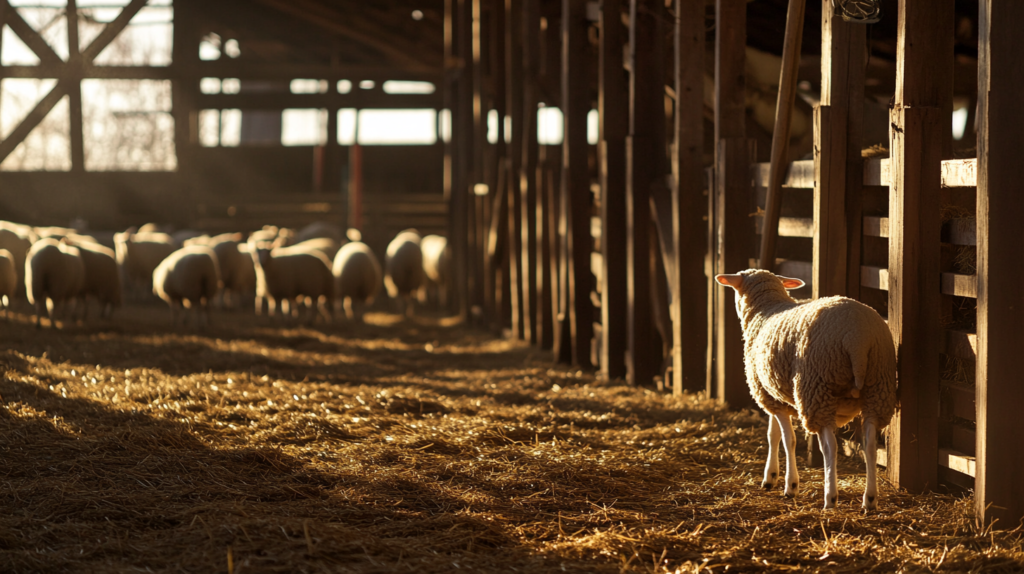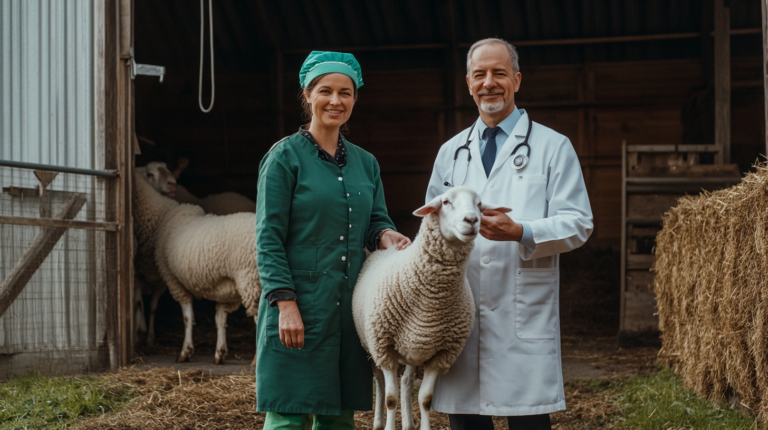Discover the 4 key symptoms of mastitis in sheep and learn the most effective treatment options in this comprehensive guide for sheep farmers and breeders.
Table of Contents
Mastitis, an inflammatory condition affecting the mammary gland in sheep, represents one of the most significant health challenges faced by sheep farmers and breeders worldwide. This painful infection of the udder can drastically reduce milk production, compromise lamb growth, and in severe cases, threaten the life of the affected ewe. Recognizing mastitis in sheep early is crucial for effective treatment and preventing the spread of infection throughout your flock. Whether you’re an experienced shepherd or new to sheep farming, understanding the key symptoms of mastitis and knowing the most effective treatment options can save you considerable time, money, and heartache while ensuring the wellbeing of your animals.
In this comprehensive guide, we’ll explore the four key symptoms that indicate mastitis in sheep, examine the underlying causes, and provide detailed information on the most effective treatment options available today. Additionally, we’ll share preventative strategies to help minimize the occurrence of this challenging condition in your flock. Let’s dive into understanding mastitis in sheep to better protect the health and productivity of your ewes.


What is Mastitis in Sheep?
Definition and Types
Mastitis in sheep is an inflammation of the mammary gland, typically caused by bacterial infection. This condition can affect one or both sides of the udder and varies in severity from mild subclinical cases to severe acute infections that can be life-threatening.
Mastitis in sheep can be classified into several types:
- Clinical Mastitis: Characterized by visible symptoms including abnormal milk, udder swelling, and systemic illness. Clinical mastitis can be further divided into:
- Acute Mastitis: Severe, sudden-onset form with pronounced symptoms including fever and illness
- Chronic Mastitis: Persistent infection that may result in permanent udder damage and fibrosis
- Subclinical Mastitis: Shows no visible symptoms but causes decreased milk production and quality. This form can only be detected through milk testing and is often the most economically damaging due to its hidden nature.
- Gangrenous Mastitis: A severe form caused by toxin-producing bacteria, leading to tissue death in the udder. The affected part may turn blue or black and feels cold to the touch.
Prevalence and Economic Impact
Mastitis in sheep represents a significant economic burden for sheep farmers worldwide. Research indicates that:
- The prevalence of subclinical mastitis in dairy sheep flocks ranges from 5-30% depending on management practices
- Clinical mastitis affects approximately 5% of ewes annually in well-managed flocks
- The condition accounts for 8-25% of premature culling of ewes in commercial operations
- Economic losses stem from reduced milk production, decreased milk quality, treatment costs, and increased mortality rates
Studies estimate that mastitis in sheep costs the global sheep industry hundreds of millions of dollars annually through direct and indirect losses, making it one of the most economically significant diseases affecting sheep production systems.
4 Key Symptoms of Mastitis in Sheep
Early recognition of mastitis symptoms can dramatically improve treatment outcomes and minimize production losses. Here are the four primary symptoms to watch for:
1. Udder Abnormalities
The most visible signs of mastitis in sheep appear in the udder itself:
- Swelling and inflammation: The affected half or the entire udder becomes enlarged, hot to the touch, and painful when palpated
- Discoloration: In acute cases, the udder may appear reddened; in gangrenous mastitis, the affected tissue may turn blue, purple, or black
- Texture changes: The udder might feel harder than normal due to inflammation or, in chronic cases, develop a lumpy consistency due to scar tissue formation
- Asymmetry: One half of the udder may appear larger or hang lower than the other, particularly in unilateral cases
- Reduced milk flow: The affected teat may produce less milk or completely cease production
Regular udder examination during lactation is essential, as subtle changes in udder appearance or texture often provide the earliest indication of developing mastitis.
2. Milk Abnormalities
Changes in milk composition and appearance are hallmark signs of mastitis in sheep:
- Consistency changes: Milk may become watery, thick, or clotted
- Color abnormalities: Instead of normal white or creamy appearance, infected milk may appear:
- Yellow or straw-colored
- Pink or red (indicating blood presence)
- Blue-gray
- Brown or dark-colored in severe cases
- Presence of clots, flakes, or pus: Visible solid particles in the milk indicate infection
- Reduced volume: Significant decrease in milk production from the affected gland
- Unusual smell: Infected milk may have a foul or unusual odor
The California Mastitis Test (CMT), which involves mixing a reagent with milk samples to detect elevated somatic cell counts, can help identify subclinical cases of mastitis where visual examination may not reveal obvious abnormalities.
3. Behavioral Changes
Ewes suffering from mastitis often exhibit notable behavioral changes:
- Reluctance to let lambs nurse: Ewes may prevent lambs from nursing due to pain when the udder is touched
- Altered stance: Affected sheep may stand with hind legs spread apart to reduce pressure on the painful udder
- Reduced mobility: Reluctance to move or lameness on the side of the affected udder
- Decreased appetite: Infected ewes often show reduced feed intake
- Increased lying time: Sheep may spend more time lying down to avoid the discomfort of standing
- Isolation from the flock: Sick ewes may separate themselves from the main group
- Head turning: Frequent turning to look at or attempt to lick the painful udder
These behavioral changes can serve as early warning signs, particularly in extensive management systems where individual animal examination occurs less frequently.
4. Systemic Symptoms
In more severe cases, mastitis in sheep can progress beyond a localized infection to affect the entire body:
- Elevated temperature: Fever above 104°F (40°C) is common in acute cases
- Depression and lethargy: Affected animals appear dull and unresponsive
- Loss of appetite: Complete refusal of feed in severe cases
- Increased respiratory and heart rate: Breathing may become more rapid and labored
- Dehydration: Reduced water intake and fluid loss can lead to dehydration
- Weakness or recumbency: In advanced cases, sheep may be unable to stand
- Weight loss: Prolonged cases result in notable condition loss
- Septic shock: In the most severe cases, bacteria or their toxins enter the bloodstream, causing potentially fatal systemic shock
Systemic symptoms indicate a serious infection requiring immediate veterinary intervention. Without prompt treatment, the mortality rate for severe systemic mastitis can exceed 50% of affected animals.
Causes of Mastitis in Sheep
Understanding the underlying causes of mastitis is essential for both treatment and prevention:
Bacterial Infections
The vast majority of mastitis cases in sheep are caused by bacterial infections:
- Staphylococcus aureus: The most common causative organism, responsible for approximately 40-60% of clinical mastitis cases in sheep. S. aureus produces toxins that can lead to gangrenous mastitis.
- Streptococcus species: Particularly Streptococcus agalactiae and Streptococcus uberis, account for 15-20% of infections.
- Mannheimia haemolytica: Often associated with nursing lambs carrying the bacteria in their mouths.
- Escherichia coli (E. coli): Environmental bacteria typically causing acute cases with severe systemic signs.
- Pseudomonas aeruginosa: Environmental pathogen often associated with contaminated water sources.
- Pasteurella multocida: Can cause severe acute mastitis.
- Mycoplasma species: Less common but often leads to difficult-to-treat infections.
Different bacterial species tend to create distinct patterns of infection, which can help guide treatment approaches.
Environmental Factors
Several environmental conditions increase the risk of mastitis development:
- Poor hygiene in housing areas: Dirty bedding and high bacterial loads in the environment
- Wet, muddy conditions: Create ideal environments for bacterial proliferation and compromise teat skin integrity
- Overcrowding: Increases stress and pathogen transmission
- Weather extremes: Both very hot and cold conditions can stress animals and affect immune function
- Inadequate ventilation: Poor air quality in indoor housing can contribute to increased pathogen loads
Management Practices
Certain management decisions and practices can significantly influence mastitis incidence:
- Improper milking techniques: In dairy sheep, poor milking hygiene or improper machine settings
- Weaning methods: Abrupt weaning without proper udder management
- Cross-nursing: Allowing lambs to nurse from multiple ewes can spread infection
- Failure to cull chronic cases: Maintaining ewes with recurring mastitis in the flock
- Improper nutrition: Vitamin E and selenium deficiencies have been linked to increased mastitis susceptibility
Physical Trauma and Injury
Physical damage to the udder or teats can create entry points for bacteria:
- Teat injuries: Cuts, abrasions, or chapping that breach the natural protective barrier
- Udder conformation issues: Pendulous udders more prone to injury
- Lamb nursing behavior: Aggressive nursing, especially from older lambs with teeth
- Predator attack: Attempted predation can result in udder injuries
- Barbed wire or sharp objects: Environmental hazards causing udder lacerations
Diagnosis of Mastitis in Sheep
Accurate diagnosis is crucial for implementing effective treatment strategies:
Physical Examination
A thorough physical examination remains the primary diagnostic approach:
- Visual inspection: Checking for asymmetry, swelling, or discoloration
- Palpation: Feeling for heat, pain, hardness, or textural changes
- Strip cup test: Examining the first few streams of milk for abnormalities
- Temperature assessment: Checking for fever in suspected cases
Laboratory Testing
When available, laboratory testing provides definitive diagnosis:
- Somatic Cell Count (SCC): Elevated counts indicate inflammation; normal levels in sheep are typically below 500,000 cells/ml
- California Mastitis Test (CMT): A cow-side test that can be adapted for sheep to detect elevated somatic cells
- Bacterial culture and sensitivity: Identifies the specific pathogen and determines appropriate antibiotic selection
- Milk pH testing: Mastitic milk typically has an elevated pH compared to normal milk
- PCR testing: More advanced molecular diagnostic for specific pathogens
- Complete blood count: May show elevated white blood cells in systemic cases
Differential Diagnosis
Several other conditions may present similar symptoms to mastitis:
- Udder edema: Common around lambing but lacks inflammatory signs
- Udder hematoma: Results from trauma but without infectious components
- Caseous lymphadenitis (CL): May cause abscess near the udder but affects lymph nodes
- Udder dermatitis (orf): Viral skin condition affecting the udder surface
- Galactostasis: Milk accumulation without inflammation, often post-weaning
- Contagious agalactia: A mycoplasma infection with broader symptoms
Treatment Options for Mastitis in Sheep
Effective treatment depends on early intervention and appropriate therapy selection:
Antibiotic Therapy
Antibiotics remain the cornerstone of mastitis treatment:
- Intramammary antibiotics: Directly infused into the affected udder half
- Commonly used products include preparations containing cloxacillin, cephalosporins, or neomycin-based combinations
- Proper cleaning of the teat and aseptic technique is essential for administration
- Systemic antibiotics: Administered via injection for more severe or systemic cases
- Penicillin-based antibiotics (including amoxicillin and ampicillin)
- Oxytetracycline
- Florfenicol
- Tylosin
- Ceftiofur
The choice of antibiotic should ideally be based on culture and sensitivity testing. Treatment duration typically ranges from 3-5 days, though severe cases may require longer courses. Always observe proper withdrawal periods for milk and meat when using antibiotics.
Supportive Care
Alongside antimicrobial therapy, supportive treatments improve recovery rates:
- Frequent milk-out: Gentle but complete emptying of the affected gland every 4-6 hours
- Cold/heat therapy: Cold compresses in acute stages (first 24-48 hours) followed by warm compresses to improve circulation
- Anti-inflammatory medications: NSAIDs such as flunixin meglumine, meloxicam, or ketoprofen to reduce pain, inflammation, and fever
- Fluid therapy: IV or subcutaneous fluids for dehydrated animals
- Oxytocin: Small doses (5-10 IU) to facilitate milk let-down and gland emptying
- Vitamin E and selenium: Supplementation may support immune function
- Teat sealants: Can be used at the end of treatment to prevent reinfection
Alternative and Complementary Treatments
Some producers incorporate alternative approaches alongside conventional treatments:
- Herbal compresses: Preparations using herbs with anti-inflammatory properties such as comfrey or calendula
- Essential oils: Certain essential oils like tea tree, oregano, or thyme have demonstrated antimicrobial properties in research studies
- Udder salves: Combination products containing natural anti-inflammatory and antimicrobial ingredients
- Probiotics: Some evidence suggests beneficial bacteria may help restore normal udder microflora
- Homeopathic remedies: While scientific evidence is limited, some producers report benefits from remedies such as Phytolacca or Bryonia
These alternative treatments should generally complement rather than replace conventional therapy, especially in severe cases.
Management of Severe Cases
Gangrenous or severe mastitis requires intensive intervention:
- Aggressive antibiotic therapy: Often using combination antimicrobials
- Intravenous fluid support: To prevent or treat shock
- Udder amputation: In gangrenous cases, surgical removal of the affected half may be necessary
- Euthanasia: In cases with poor prognosis, humane euthanasia may be the most appropriate option
The prognosis for gangrenous mastitis is guarded, with mortality rates exceeding 50% even with appropriate treatment.
Prevention Strategies for Mastitis in Sheep
Prevention remains far more effective than treatment:
Husbandry and Management Practices
Implementing proper management significantly reduces mastitis risk:
- Maintain clean, dry bedding: Regular bedding changes and proper drainage
- Appropriate stocking density: Avoid overcrowding, which increases stress and pathogen transmission
- Regular udder inspection: Check ewes’ udders periodically, especially around lambing
- Proper nutrition: Balanced diet with adequate vitamin E and selenium
- Weaning management: Gradual weaning or “milk-out” after abrupt weaning
- Culling policy: Remove ewes with chronic or recurrent mastitis from the breeding flock
- Lamb management: Prevent lambs from nursing multiple ewes when possible
Milking Hygiene in Dairy Sheep
For dairy operations, proper milking protocols are essential:
- Pre-milking teat disinfection: Cleaning teats before milking
- Post-milking teat dipping: Application of approved teat disinfectants after milking
- Proper milking machine function: Regular maintenance and appropriate settings
- Milking order: Milk young and healthy ewes before older or previously infected animals
- Machine cleaning: Thorough sanitation of milking equipment
Vaccination
Vaccines may provide additional protection:
- Staphylococcus aureus vaccines: Some commercial vaccines are available for S. aureus mastitis prevention
- Autogenous vaccines: Custom-made from bacteria isolated from the flock
- Clostridial vaccines: May reduce certain forms of gangrenous mastitis
Vaccine efficacy varies considerably, and they should be considered as part of a comprehensive prevention program rather than a standalone solution.
Genetic Selection
Breeding for resistance offers long-term benefits:
- Udder conformation: Select for well-attached, properly shaped udders
- Genetic resistance markers: Some breeding programs now include selection for mastitis resistance
- Cull susceptible lines: Remove families with recurring mastitis problems from breeding programs
Recommended Products for Sheep Mastitis Management on Amazon
Recommended Products
- TeatShield Udder Balm for Sheep and Goats: A protective and soothing balm containing natural antibacterial ingredients to support udder health and prevent teat cracking.
- MastitDetect Test Strips: Easy-to-use test strips that detect elevated somatic cell counts in milk, allowing for early identification of subclinical mastitis.
- Shepherd’s Friend Udder Support Harness: Provides support for pendulous udders, reducing trauma risk and supporting recovery from mastitis.
- OviClean Teat Disinfectant: A gentle yet effective iodine-based teat dip formulated specifically for sheep, helping prevent bacterial contamination.
Frequently Asked Questions About Mastitis in Sheep
FAQ Section
Q: How quickly does mastitis develop in sheep?
A: Mastitis development can vary considerably. Acute mastitis can develop within 24-48 hours of bacterial invasion, while chronic mastitis may develop slowly over weeks. Gangrenous mastitis can progress very rapidly, with tissue death occurring within 48-72 hours of initial infection.
Q: Can mastitis in sheep spread to other ewes?
A: Yes, mastitis can spread between ewes, particularly contagious forms caused by bacteria like Staphylococcus aureus. Transmission typically occurs through contaminated bedding, milking equipment, handlers’ hands, or cross-nursing of lambs. Implementing proper hygiene practices and isolating affected animals can help limit spread.
Q: Will a ewe recover fully from mastitis?
A: Recovery depends on the severity and promptness of treatment. Mild cases treated early generally recover completely. However, severe or chronic mastitis often results in permanent damage to the affected udder half, reduced milk production capacity, or complete loss of function in that half. Gangrenous mastitis frequently results in loss of the affected tissue or death of the animal.
Q: How long should I treat mastitis in sheep?
A: Treatment duration typically ranges from 3-5 days for mild to moderate cases. Severe or chronic cases may require 7-10 days of antibiotic therapy. Always follow the complete prescribed course of antibiotics, even if symptoms improve, and observe proper withdrawal periods for milk and meat.
Q: Can I still use milk from a ewe with mastitis?
A: Milk from a ewe with mastitis should not be consumed by humans or fed to lambs. The milk contains bacteria, inflammatory cells, and potentially antibiotic residues if the animal is under treatment. Discard milk from affected glands until the infection has cleared and any antibiotic withdrawal period has been observed.
Q: How can I tell the difference between mastitis and normal changes after weaning?
A: Post-weaning udder engorgement (galactostasis) typically affects both halves of the udder evenly, feels firm but not hot or painful, and resolves gradually over several days. The milk remains normal in appearance. In contrast, mastitis typically causes significant pain, heat, and visible changes in milk quality. When in doubt, consult with a veterinarian for proper diagnosis.
Q: What are the withdrawal periods for antibiotics used to treat mastitis?
A: Withdrawal periods vary depending on the specific antibiotic used and can range from 7-28 days for meat and 2-7 days for milk. Always check the label of the specific medication used or consult with your veterinarian about appropriate withdrawal times. Failing to observe withdrawal periods can result in illegal residues in food products.
Q: Is mastitis more common at certain times of the year?
A: Mastitis incidence often increases during specific periods: immediately after lambing, during peak lactation, during weaning, and during wet weather conditions. Extreme weather (both hot and cold) can also stress animals and increase susceptibility. In dairy operations, incidence may increase during transition periods between housing systems.
Conclusion
Mastitis in sheep represents a significant health and economic challenge for sheep producers worldwide. By understanding the four key symptoms—udder abnormalities, milk changes, behavioral indicators, and systemic signs—producers can identify and address infections promptly. Implementing a comprehensive approach combining appropriate antibiotic therapy, supportive care, and preventative management practices offers the best strategy for controlling this condition.
Remember that prevention through good husbandry, proper nutrition, and genetic selection remains far more effective than treatment. Regular monitoring of your flock, particularly during high-risk periods, allows for early intervention when issues arise. When mastitis does occur, prompt and appropriate treatment not only improves outcomes for individual animals but also protects the health and productivity of your entire flock.

For more expert recommendations and guides on sheep health and management, visit BlithePet where you’ll find additional resources to support your livestock care practices.
Have you encountered mastitis in your sheep flock? Share your experience and treatment approaches in the comments below!





